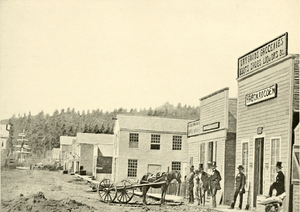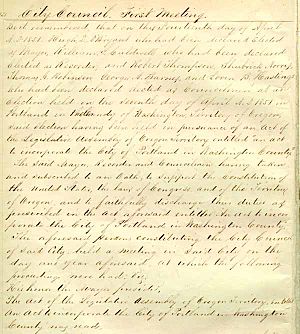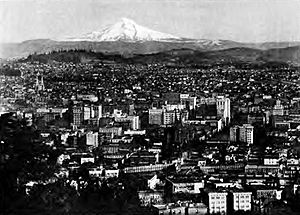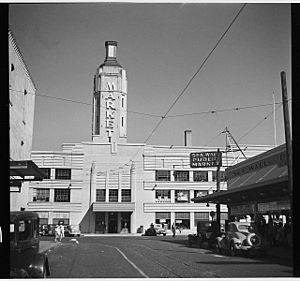History of Portland, Oregon facts for kids
The city of Portland, Oregon, began in 1843. That year, two business partners, William Overton and Asa Lovejoy, decided to claim land on the west bank of the Willamette River in a region called Oregon Country. In 1845, the name of Portland was chosen for this new community by a coin toss. The city officially became a city on February 8, 1851. Portland has continued to grow, with 583,776 people living there in 2010.
Early History of the Area
The land where Multnomah County, Oregon is today was home to two groups of Upper Chinook Indians for many centuries. The Multnomah people lived on and around Sauvie Island. The Cascades Indians settled along the Columbia Gorge.
These groups were skilled at fishing and trading along the river. They also gathered berries, wapato (a root vegetable), and other plants. The nearby Tualatin Plains were excellent hunting grounds. Sadly, when Europeans arrived, many native people became sick from diseases like smallpox and malaria.
How Portland Was Founded
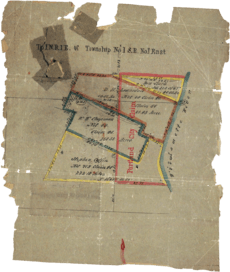
The area that would become Portland was known as "The Clearing" by traders and settlers in the 1830s and early 1840s.
William Overton, one of the first land claimants, soon sold his share to Francis W. Pettygrove of Portland, Maine, in 1845. When it was time to name their new town, Pettygrove and Asa Lovejoy both wanted to name it after their hometowns. They decided to flip a coin. Pettygrove won, and that's how Portland got its name!
Later, Lovejoy sold his share of the land to Benjamin Stark in 1846. Pettygrove also sold his part of the townsite to Daniel H. Lownsdale in 1848.
In 1849, Lownsdale shared the Portland land claim with Stephen Coffin. Later, William W. Chapman also bought a share. These partners worked together to develop the growing town.
At first, Portland was less important than Oregon City, which was the capital of the Oregon Territory. Oregon City was about 12 miles upstream at Willamette Falls. However, Portland had a big advantage. It was located where the Willamette River met the Columbia River, which meant large ships could reach it easily.
Early Portland was a challenging place. Tree stumps were everywhere, and people and wagons often got stuck in mud. Sidewalks sometimes disappeared during spring floods!
The first group of volunteer firefighters was formed in the early 1850s. In 1854, the city council officially created the Portland Fire Department.
Portland in the Late 1800s
A large fire swept through downtown Portland in August 1873. It destroyed 20 blocks along the Willamette River. The fire caused a lot of damage, costing about $1.3 million. In 1889, a local newspaper called Portland "the most filthy city" because of its poor sewers.
The first Morrison Street Bridge opened in 1887. It was the first bridge to cross the Willamette River in Portland.
For much of the 1800s, Portland was the main port in the Pacific Northwest. But in the 1890s, Seattle gained a direct railroad connection to the east. This meant goods could be shipped from Seattle without needing to cross the dangerous sandbar at the mouth of the Columbia River.
In 1891, Portland grew by merging with the nearby towns of Albina and East Portland.
Portland in the Early 1900s
In 1905, Portland hosted the Lewis and Clark Centennial Exposition, which was like a world's fair. This event made the city more famous and helped its population double. The number of people living in Portland grew from 90,426 in 1900 to 207,214 in 1910. In 1915, Portland merged with Linnton and St. Johns.
In July 1913, there was a "free speech fight" in Portland. This happened during a strike by women workers at the Oregon Packing Company. The mayor made it illegal to speak publicly on the streets, except for religious speeches. This rule was meant to stop the Industrial Workers of the World from speaking out to support the striking workers.
On June 9, 1934, about 1,400 members of the International Longshoremen's Association (ILA) went on strike. This strike stopped shipping in every port along the West Coast. The workers wanted their union to be recognized, higher pay, shorter workdays, and more control over hiring. There were some clashes between strikers and police during this time. The longshoremen returned to work on July 31, 1934, and their demands were later settled through a process called arbitration.
Portland in the Mid-1900s
In 1940, Portland was about to experience a huge growth in its economy and population. This growth was helped by:
- Over $2 billion spent by the U.S. government to expand the Bonneville Power Administration.
- The need to produce supplies for World War II.
This growth was led by Henry J. Kaiser. His company had built two dams on the Columbia River. In 1941, Kaiser Shipyards received contracts to build ships for the war. He chose Portland as one of the locations for his shipyards. He built two shipyards along the Willamette River and another nearby in Vancouver. Kaiser hired 150,000 workers for these shipyards. These new workers played a big part in Portland's growth, as the city added 160,000 residents during World War II.
By the end of the war, Portland had a population of 359,000. Another 100,000 people lived or worked in nearby cities like Vanport and Oregon City.
In the 1940s and 1950s, there were some issues with organized crime in Portland.
Public transportation in Portland changed from private companies to public ownership between 1969 and 1970. The private companies were struggling to make money. A new government agency, the Tri-County Metropolitan Transportation District (Tri-Met), took over the bus lines.
Portland in the Late 1900s
During the "dot-com boom" of the mid-to-late 1990s, many young people in their 20s and 30s moved to Portland. This was a time when many new internet companies were starting.
Portland's Cultural History
The visual arts have always been important in the Pacific Northwest. In the mid-1990s, there was a big increase in the number of artists, independent galleries, and public discussions about art in Portland. Several art publications were also started.
Portland's art scene during this time was noticed by major art magazines like ARTnews and Art in America. A former curator from the Whitney Museum, Lawrence Rinder, was a big supporter of Portland's changing art scene. The Wall Street Journal also mentioned how lively Portland's alternative art spaces were.
Images for kids



